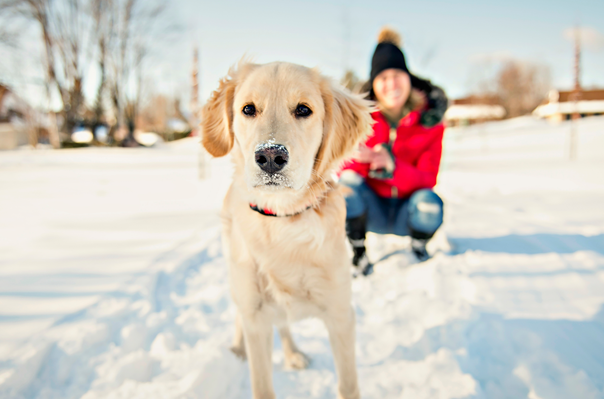
Did you make a resolution to exercise this year? Many of us sign up for gym memberships in January. It seems like a tradition to resolve to exercise more in the new year. After the excesses of the holiday season, we’re ready to focus on our health, breaking old habits and creating new, healthy ones.
While you’re focusing on improving your health, why not help your dog get healthy as well! Walking is an easy way to improve your health without the pain of gym fees – and it’s great for your dog, too. Not to mention, your dog is the perfect exercise partner – always available and willing to accompany you on a walk.
How does walking keep my dog healthy?
Walking your dog is a simple task that has a positive impact on many aspects of overall health:
- Weight and Body Condition: Walking helps your dog keep a healthy weight. Obesity is a major health issue and obese dogs do not live as long as lean dogs. Plus, they suffer more heart problems and joint ailments that affect their quality of life. The solution is to burn more calories than consumed. Regular exercise, like walking, is a great way to burn those excess calories.
- Joint Health: A sedentary lifestyle leads to a variety of health problems. People and pets get stiff when we sit for too long, and keeping joints in motion improves their function. Not to mention, moving around also helps keep muscles active and strong.
- Digestive and Urinary Health: Regular walking helps regulate the digestive tract. Some dogs, like some people, prefer to “go” on a schedule and providing your dog with routine trips outdoors prevents constipation. Also, when urine sits in the bladder for long periods of time, bladder infections are more likely to occur, so regular emptying is important.
- Mental Health: Walking exercises the mind as well as the body. If you give your dog something constructive to do, like taking a walk, they may be less likely to do something destructive, like chewing the couch. Walks provide great mental stimulation for dogs that they can’t get in the same fenced area all the time. On a walk, your dog can watch wildlife, explore new paths, see other people and pets, smell new things, and so much more. Walking also releases excess energy and helps dogs (and you!) sleep better at night.
- Emotional Health: You are the center of your dog’s universe, and he craves your attention. What better way to share quality time than taking a walk? Spending one-on-one time with your dog will deepen your bond and help deter annoying, attention-seeking behaviors such as excessive barking or whining.
How do we get started?
The best way to stick to your resolution is to make a reasonable, achievable exercise plan that does not overwhelm you.
- Create a daily walking schedule that does not overtax your body or crowd your busy schedule. Your dog will give you motivation to get going.
- Start out slowly by taking a few 10-minute practice walks around the neighborhood. When you and your dog are ready, increase the time and distance. Try to walk for a total of 30 minutes each day – it doesn’t have to be all in one outing.
- Keep the routine interesting by walking in different areas that provide visual interest for both you and your dog. Or substitute a game of fetch or a romp in the park if you feel up to it.
The goal is to make exercise a priority that holds a scheduled spot in each day so that you feel less likely to avoid your plan. It will not take long for your dog to get used to the routine and they may remind you when it is time to exercise. That is just one reason why canines are great exercise companions.
Consider tracking your progress with an exercise app or electronic tracking device that records daily steps and caloric history. Sometimes, seeing the numbers provides additional motivation to walk a little further or validates your efforts when you reach your goal.
As you embark on a healthy new year, take your dog with you, and improve both your lives! A simple stroll is a great way to say, “I love you.”
